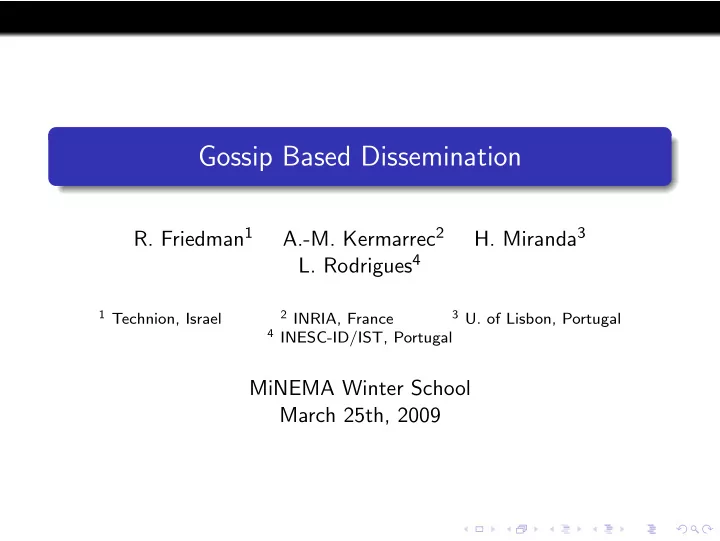

Gossip Based Dissemination R. Friedman 1 A.-M. Kermarrec 2 H. Miranda 3 L. Rodrigues 4 1 Technion, Israel 2 INRIA, France 3 U. of Lisbon, Portugal 4 INESC-ID/IST, Portugal MiNEMA Winter School March 25th, 2009
Gossip Example The Election Rumour Case study In 2005 campaign for the elections for the Portuguese parliament, one of the candidates spent 10m of the only debate on national TV: Denying a rumour All candidates condemned the spreading of the rumour Media have frequently referred to it as “the rumour” Neither ever mentioned what the rumour was about But... The whole country knew what the rumour was about Curious ?
Gossip Example The Election Rumour How to address your curiosity? The test of the three questions (Socrates, 469-399 B.C) Are you sure? Is it something good? Is it useful? The class would be over
Gossip Example The Election Rumour How to address your curiosity? The test of the three questions (Socrates, 469-399 B.C) Are you sure? Is it something good? Is it useful? The class would be over The push approach I tell you the rumour
Gossip Example The Election Rumour How to address your curiosity? The test of the three questions (Socrates, 469-399 B.C) Are you sure? Is it something good? Is it useful? The class would be over The push approach I tell you the rumour The pull approach I told you that I know a rumour You’ll ask if you want to know
Gossip Example The Election Rumour How many times will I have to say it? � 92 − 12 92 participants ≈ 7? 12 Portuguese 12 Or Each Portuguese tells to 3 other participants 12 × 3 = 36
Gossip Example The Election Rumour How many times will I have to say it? � 92 − 12 92 participants ≈ 7? 12 Portuguese 12 Or Each Portuguese tells to 3 other participants 12 × 3 = 36 Each of the 36 tells to 3 other 36 × 3 = 108 > 92
Gossip Example The Election Rumour How hard is it to get 10 millions? 12 × 3 × 3 × 3 × 3 × 3 × 3 × 3 × 3 × 3 × 3 × 3 × 3 × 3 = 19131876 13 rounds
Epidemic Dissemination Examples The Great Plague (14th Century) Killed 75M people worldwide In Europe: 25-50M (30%-60% of Europe’s population) Started in Asia Transported to Europe by merchants over the route of silk Used as weapon by Mongols The Spanish Flu (1918-1920) Killed 50M-100M people worldwide India, North America, Europe, Australia, Western Samoa, Fiji Islands Started in Fort Riley, Kansas, US Infected soldiers were deployed in different places in Europe Source: Wikipedia
Epidemic Dissemination Pattern Infection occurs upon spontaneous contacts between individuals Infected individuals become infection agents Properties Scalable Resilient to failures See measures to control birds flu
May Not Work What would have happened if. . . The silk route didn’t existed? – or – American soldiers remained in Fort Riley? People used the Socratic approach on rumours? – or – The diseases killed instantly? ⇓ Dissemination would have been interrupted
Computers don’t gossip,,, do they? Some computer virus algorithm At each computer Peek a few IP addresses chosen at random 1 Infect them (if possible) 2 Do some harm on this computer 3 Note: the order is important
Gossip algorithms Outline Sender thread Forever Receiver thread 1 peak fanout nodes from Forever local node list (the 1 receive message view) 2 compare buffer with 2 send message [push] the messages in 3 for each message m not the buffer in the buffer [pull] the ID of the messages in the buffer If “pull”: request m 1 Deliver m 2 3 purge buffer from old Add m to the buffer 3 messages 4 sleep
Questions What is an “old” message? FIFO Random based Semantic based How to build a view in large scale? Random walk of “join” messages Use a gossip protocol
Robust? What would happen if. . . nodes were clustered, sharing similar views? all infected nodes are affected by a failure? message is removed from buffer at all infected nodes? More likely in early stages of dissemination ⇓ Bimodal behaviour
Applications On Wired Networks Large scale applications. . . Database consistency Data fusion/aggregation Data dissemination Peer sampling
Is Gossip Applicable in Infrastructure-less Networks? Not directly: Gossip is resource consuming rounds × fanout messages per node Each message may trigger a route request Each route request may require a flooding Route Driven Gossip Populates the view with nodes at the route cache of reactive routing protocols [536]
Tailoring Gossip to Infrastructure-less Networks Redefining a view A view of node n is the list of nodes within transmission range of n fanout = # view Redefining sleep time Nodes sleep while their buffer doesn’t change
Tailoring Gossip to Infrastructure-less Networks Advantages All nodes in the view can be reached by a single transmission Implications Changes in the view are mostly dictated by node movement The view size is outside the control of the algorithm Clustering
Problem Solved? Not yet! We’re using a shared medium: All nodes will wake to retransmit the new message Compete for the medium Produce collisions ⇓ Broadcast Storm [818]
Selecting Retransmitters Infection can be propagated with a small number of retransmissions Different approaches for selection of retransmitters Probabilistic Counter-based Distance-based Mix of the above Requirement: decision should be local to each node
Probabilistic Selection GOSSIP1(p) [353] Upon reception of a message for the first time, nodes retransmit with probability p Flooding: p = 1 Highly vulnerable in the neighbourhood of the source
Biased Probabilistic Selection GOSSIP1(p,k) [353] A node retransmits with p = 1 if located at less than k hops from the source or with p otherwise Vulnerable to low densities elsewhere GOSSIP2(p1,k,p2,n) [353] A node retransmits with p 2 if it has less than n neighbours. Uses GOSSIP1(p,k) otherwise. How to learn n ? What is a good value for p 1?
Recommend
More recommend